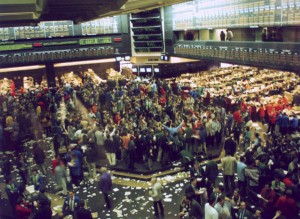
A farmer lives with two time horizons in mind. One is the months-long growing seasons his crops abide by. The other is the immediate reality of having to feed his family each day, regardless of the price of grain at harvest in three months, whether a drought will wither plants in the field, or whether perfect rains will yield a bumper crop.
Across rural Africa, such uncertainty hounds smallholder farmers—which is nearly everyone. In Ethiopia, 80 percent of the population of more than 80 million are small-scale farmers and produce 95 percent of the country’s agricultural output.
If more and better information within agricultural markets can make uncertainty recede like darkness in front of a candle, the Ethiopian Commodity Exchange is a bank of high-powered floodlights. A commodity exchange that broadcast crop prices to rural farmers not only helps them get higher prices for their produce, but also improves the food distribution system to resist shortages in times of drought.
That’s from a recent article in GOOD magazine by Tate Watkins.
The article discusses the potential for commodity exchanges to improve food security in Africa. In a nutshell, at times of impending food scarcity, commodity exchanges can help by raising food prices, which can help avert food crises and famines. This helps food consumers by improving their food security.
But commodity exchanges can help food producers by smoothing prices over time. That is, commodity exchanges can help reduce the uncertainty over the prices farmers will face come harvest time, which in turn leads farmers to making more efficient production decisions.
What about Commodity Speculation?
This is in stark contrast with the oft-touted “fact” according to which commodity speculation caused the food crisis of 2008. If you are interested in commodity speculation, see this Energy Economics article by Scott Irwin and Dwight Sanders, in which the authors argue that there is little to no causal evidence that commodity speculation led to the 2008 spike in food prices.
Tate interviewed me for the GOOD magazine article quoted above, and one of the things I said ended up making it to the article. I will always be grateful to Tate for bringing to my attention the Kansas City Star‘s style guide, which supposedly helped Ernest Hemingway develop his distinctive style. Tate has his own blog here, and you can follow him on Twitter here.
